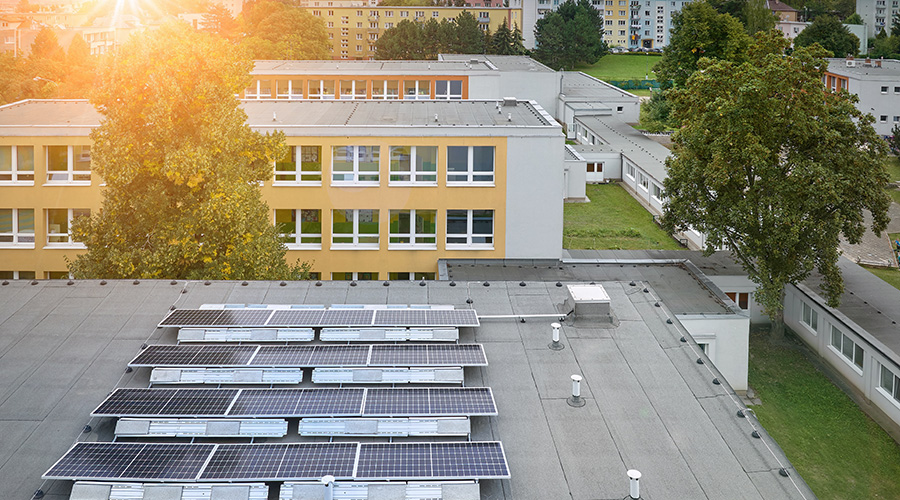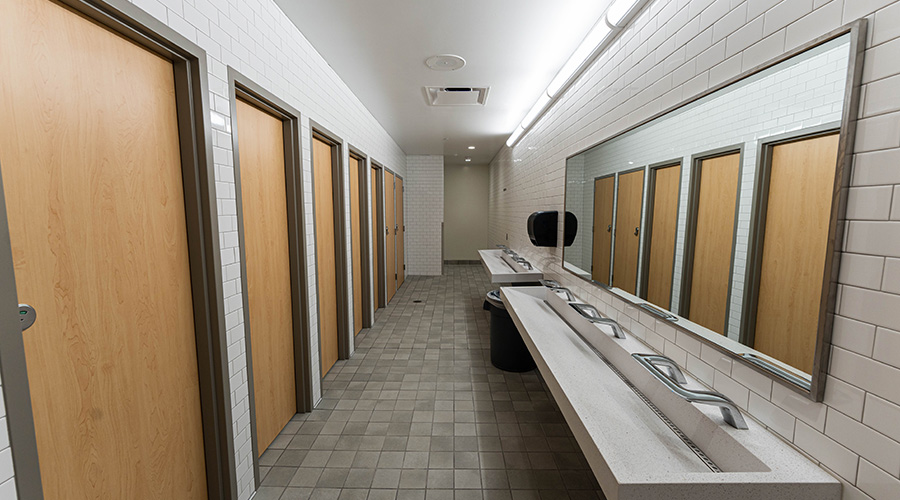Blazing a ‘Green’ Trail
An early adopter of LEED-EB guidelines, the Buffalo School District learns valuable lessons about maintenance and the environment
When Buffalo School District officials began considering schools that could take part in the first phase of its district-wide reconstruction project in 2001, they quickly identified Stanton Academy, an elementary school, as a prime candidate. While the 80-year-old facility was in good structural shape, its infrastructure needed significant upgrades to meet today’s technology requirements.
Soon, it became clear to district officials that out of its more than 70 schools, Stanton Academy, known as School 31, was the most appropriate candidate for the U.S. Green Building Council’s (USGBC) Leadership in Energy and Environmental Design for Existing Buildings (LEED-EB) pilot program. LEED-EB certification focuses on the upgrade and operations of existing buildings to improve their performance and overall impact on the environment.
The USGBC had sought older schools that had not experienced major upgrades or renovations, says Mel Alston, the district’s associate superintendent for plant services and school planning. Besides upgrading equipment and creating long-term maintenance and operation efficiencies, the district was very interested in improving the environmental-friendliness of its facilities.
“School 31 seemed to be a good fit between our needs and the needs of the LEED-EB program,” he says.
Following the decision to enroll School 31 in the LEED-EB pilot program, the district’s maintenance executives began helping the organization become the first public school district in the nation to have a building undertake the LEED-EB process and turn an older facility into a certified green building.
The Maintenance Role
As part of the reconstruction project, the district’s board of education signed two contracts: one with an energy services company to ensure the building met energy-performance criteria and another with a program management company to direct the reconstruction of School 31.
Besides representatives from the design and program management companies, the project involved employees from various departments within the district’s division of plant services and school planning and its instructional division.
Mike Homewood, Stanton Academy’s chief engineer, works in the division’s operations and custodial services department. He was responsible for the day-to-day maintenance of the school and met with the contractors and other staff members early in the project’s planning phase.
For two years before construction, he, along with the school principal and a building committee, met several times with the design architects and engineers to talk about the condition of the building equipment and areas that could improve the facility’s energy efficiency.
“Whenever they visited the school, I would show them around, and we would talk about what needed to be done,” Homewood says.
Susan Eager, the district’s director of plant operations, says Homewood and others in the division also provided the designers with recommendations.
Homewood says designers often asked for his opinion on a variety of topics, including where particular functions should be housed in the building, such as computer accessibility and science classrooms.
“On the mechanical end, they asked me a lot of questions regarding the power plant, the HVAC and related equipment,” he says. “As far as specifying the equipment, I told them my opinion and they handled it from there,” Homewood says, adding that he was not involved in the purchasing process. Once construction began, he served as the main contact, along with the principal, between the construction companies and the board of education.
“Mike was the actual on-site board plant division person, working day in and day out with the contractors and trying to do the scheduling and operations of our school under construction,” Eager says.
Homewood met with the construction crewmembers several times each day to talk about different issues related to the renovation, such as paint colors and floor dimensions.
“They had specifications to work from, but they were always talking with me about when, where and how work could be done,” Homewood says.
School in Session
Scheduling work was a common topic of conversation throughout the project because teachers were conducting classes at the same time the construction workers were working in the building. Faculty and staff preferred construction work to be done when the building was vacant, but some work had to get done while classes were in session.
“In some of our reconstruction projects, we have to get work done while students are in the building, largely because we only have so many swing school options available to us or because the school provides a very popular program and it would be difficult to relocate the kids for academic reasons,” Alston says. “In the case of School 31, we relocated some of the students and faculty to a swing school, another school nearby that they could occupy while the reconstruction work was going on.”
Since construction began in September 2003, pre-kindergarten through fourth-grade students have attended classes at the swing-space building. Remaining students in School 31 were moved to different areas during the reconstruction.
The contractors “reconstructed one wing of the building while school was going on for grades fifth through eighth,” Homewood says. “Then, when we got done with that section, we moved the kids over to the completed areas, and they started on another section.”
Says Eager, “It was critical that [Homewood] be able to operate a building under construction with an instructional program going on at the same time. That’s very difficult to do, because there are dust and noise issues.”
To keep dust from construction out of classrooms, construction workers avoided operating equipment during school hours that would stir up dust.
“Because of the dust and noise factors, all demolition projects were done on the second shift when no students or instructional staff members were in the building,” Homewood says. While the reconstruction was hectic and very challenging, Homewood enjoyed working on the project.
“I pretty much lived there for a year,” he says, adding that he was often at the school 12 hours a day, six days a week.
21st Century School
The students in the swing school are scheduled to return to School 31 this November. They will find a facility designed with the latest technology, including global- positioning-system clocks, modernized audio systems and new computer stations.
Implementing green products and principles is the heart of the LEED-EB program and the district’s staff and designers focused on making the school environmentally friendly and efficient, says Ted Fyda, associate architect and project manager for the district’s division of plant services and school planning.
“For instance, instead of using vinyl tile on the floor, like what you see in a lot of schools, we used linoleum, which is basically a green product made from all natural materials,” Fyda says. Adhesives used in installing the flooring also are considered green because they create little off-gassing.
Other green-design-related efforts include installing carpet made of recycled fiber, applying a reflective coating on the roof and using only water-based interior paints. Also, the design and construction team replaced the building’s 70-year-old boiler with a higher energy-efficient dual fuel boiler system.
“Rather than having two large boilers, which would run constantly during the day, we’ve installed three small boilers that can operate more efficiently on a day-to-day basis,” Fyda says. “Depending on the temperature and conditions outside, we can use one, two or three boilers, whatever is necessary to heat the building.”
Preservation Efforts
“In a LEED school, an important aspect is reusing every piece of equipment and material that you can and not throwing old materials out and bringing in all new materials,” Eager says. The designers wanted to preserve the building’s original woodwork as much as possible, so rather than replacing most of the old wood, they refinished it.
“We kept about 85 percent of the original cabinetry and woodwork within the building by refinishing it rather than using new lumber,” Fyda says.
The designers also refurbished existing wood windows rather than replacing them with new aluminum windows. By doing this, the facility allows in more natural light, Fyda says. They also installed insulated window glass to improve the energy efficiency.
Changing of the Guard
With just a few rooms left to finish, the construction workers will soon leave the site and turn the building over to the district’s maintenance staff, which is preparing for the transition.
“On the School 31 project, we’re now at the point where we’ll be going through a series of training sessions on particular systems over the next few months before there is a final turnover of the project,” Alston says. The district addressed training for the maintenance staff in the early planning stages of the renovation.
“We’re insisting in the specifications that a lot of emphasis be put on the turning over of projects, the commissioning of the systems, and the training of our staff so that they can continue to maintain the equipment and facilities throughout their life cycle,” he says.
To further help with preventive maintenance, the district is investigating the implementation of a new CMMS system that can be used for all of the facilities in the district.
“We’re looking at what aspects of preventive maintenance should be incorporated into the system and how best the buildings are used by the district,” Fyda says. “We’re still investigating those issues and should know more as the buildings are turned over to us and get to be used over the coming months.”
The district’s division of plant services and school planning is determining the best way to preserve the building’s equipment and features.
“We took a building and brought it back to useable life again,” Alston says. “It is a building that we will be using for many years into the future with upgraded systems and new finishes. A lot of it was redone utilizing the green-design principles so that we didn’t have to completely rebuild a building but instead resurrected a building and brought it back to life again.”
The Launch of LEED-EB
In October, the U.S. Green Building Council (USGBC) announced the release of the green building rating system for its Leadership in Energy and Environmental Design for Existing Building (LEED-EB). Previously in the pilot stage, the rating system has been fully balloted by the USGBC membership and is ready to launch.
LEED-EB makes LEED certification available to existing buildings and provides an opportunity for ongoing recertification for previously certified LEED buildings. LEED-EB helps building owners and managers bring the performance of their buildings up to a high level and maintain high performance over the long term. Benefits of LEED-EB include energy and water savings, and healthier indoor environments.
For more information on LEED-EB, visit the USGBC web site.
|
Related Topics:











